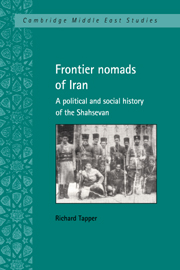Book contents
- Frontmatter
- Contents
- List of illustrations
- Preface
- Acknowledgments
- Note on transliteration
- Glossary
- 1 Writing tribal history
- PART I The Safavid state and the origins of the Shahsevan
- PART II The rise of the Shahsevan confederacy
- PART III The Shahsevan tribes in the Great Game
- PART IV The end of the tribal confederacy
- 11 Pastures new: the effects of the frontier closure
- 12 The Shahsevan, the Constitution, the Great War and after
- 13 Settlement and detribalization
- 14 Conclusion: Shahsevan identity and history
- Appendices
- Bibliography
- Index of topics
- Index of places, peoples, persons, dynasties, parties, companies
- Index of authors quoted or discussed
- Index of tribal names
- Plate section
12 - The Shahsevan, the Constitution, the Great War and after
Published online by Cambridge University Press: 05 March 2012
- Frontmatter
- Contents
- List of illustrations
- Preface
- Acknowledgments
- Note on transliteration
- Glossary
- 1 Writing tribal history
- PART I The Safavid state and the origins of the Shahsevan
- PART II The rise of the Shahsevan confederacy
- PART III The Shahsevan tribes in the Great Game
- PART IV The end of the tribal confederacy
- 11 Pastures new: the effects of the frontier closure
- 12 The Shahsevan, the Constitution, the Great War and after
- 13 Settlement and detribalization
- 14 Conclusion: Shahsevan identity and history
- Appendices
- Bibliography
- Index of topics
- Index of places, peoples, persons, dynasties, parties, companies
- Index of authors quoted or discussed
- Index of tribal names
- Plate section
Summary
Azarbaijan and the tribes up to the Constitutional Revolution
After the setback to British prestige of the scandal of the Tobacco Monopoly in 1890–2, Russia steadily increased her domination of the north, where she won important economic concessions while the Iranian government grew heavily indebted to her financially. The British were concerned with the defence of India and with maintaining their power in the Persian Gulf, which became more vital after oil was discovered in commercial quantities in 1908. Russia wanted access to a warm-water port and further outlets for her expanding trade, and felt these could be achieved only by virtual subjugation of much of Iran. Defeat by the Japanese in 1905 and the Tsar's granting of the Duma did little to halt Russian forward policy in Iran. Without consulting Iran, Russia and Britain in 1907 clarified their respective positions in a Convention which carved the country into ‘spheres of influence’: the largest sphere, in the north and northwest, went to Russia, the southeast to Britain, while the southwest and a corridor to the northeast were to be neutral.
As described in Chapter Eleven, during the years of Mohammad 'Ali Mirza's rule as heir apparent (1896–1907) the province of Azarbaijan was in continual disorder and distress, with Russian influence paramount. The Ardabil region was in turmoil. There were repeated grain shortages, due not only to bad harvests and the insecurity of cultivation but also to hoarding and speculation by landowners.
- Type
- Chapter
- Information
- Frontier Nomads of IranA Political and Social History of the Shahsevan, pp. 248 - 282Publisher: Cambridge University PressPrint publication year: 1997



